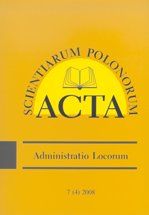Przemiany demograficzne i gospodarki rolnej w wiejskiej strefie przygranicznej Niemiec i Polski
Demographic and agricultural changes in the rural areas of the Polish-German borderland region
Author(s): Aleksandra Jezierska-Thöle, Jörg JanzenSubject(s): Economy, Geography, Regional studies, Agriculture, Human Geography
Published by: Wydawnictwo Uniwersytetu Warmińsko-Mazurskiego w Olsztynie
Keywords: border area;rural areas;demography;agriculture;Germany;Poland;
Summary/Abstract: The paper presents the results of the research of structural changes in the rural areas of the Polish-German borderland region. The main objective of this study was to determine the nature, rate and directions of the changes in the demographic structure and the rural economy. An important part of the research were case studies of individual farms in the municipalities of Letschin and Krzeszyce. The study covered the period from 2002 to 2010. The study used the methods of observation, as well as monographic, diagnostic and statistical survey. The results show an unstable demographic development. The limited labour market in the border areas contributes to the outflow of the working age population from both Märkisch-Oderland and Sulęcinto the cities of the Berlin Metropolis. The influx of working and retirement-aged populations to rural areas is associated with more attractive conditions of residence. In contrast to Märkisch-Oderland, the age structure of the poviat of Sulęcin is characterised by a higher proportion of the pre-working age population and a smaller share of those at the retirement age. The structure of land use still shows the old boundaries of large-scale collective farms. The leading form of the use of arable land of large holdings is leasing, while private property accounts for only 10-20%. In Poland, however, the share of ownership of small farms is 80-90%.
Journal: Acta Scientiarum Polonorum Administratio Locorum
- Issue Year: 11/2012
- Issue No: 3
- Page Range: 97-108
- Page Count: 12
- Language: Polish

